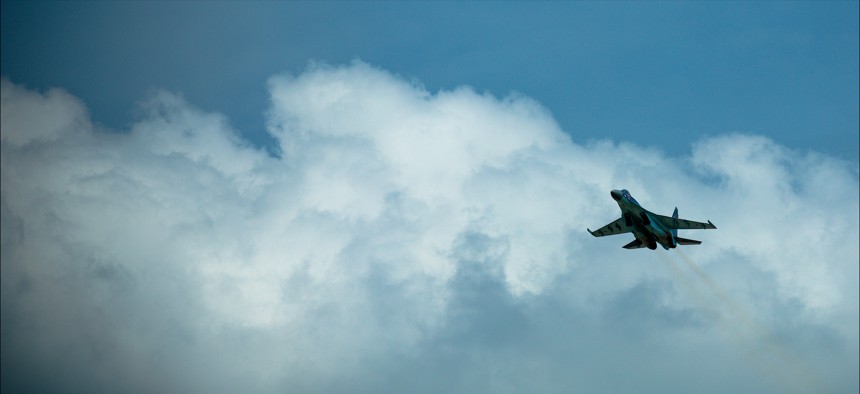
Sukhoi Su35 demonstration at Paris Air Show "Le Bourget". Flickr user Adrien Sifre
As Moscow Sends Fighter Jets Into Syria, US and Russian Defense Chiefs Open Talks
Four Russian Flankers have arrived at Moscow’s forward operating base in Syria, Pentagon confirms.
U.S. Defense Secretary Ash Carter made his first call to his Russian counterpart on Friday, to discuss a rapid buildup of Russian military and equipment in Syria — including, Pentagon officials soon confirmed, the arrival of four combat jets at the Russian forward operating base in Latakia.
The talks were the first of their kind since the U.S. broke off military-to-military contact with Russia in March 2014, after its aggression in Ukraine. The conversation was prompted by diplomatic back-and-forth between Russian Foreign Minister Sergei Lavrov and Secretary of State John Kerry, a Defense Department official said.
“Before there was nothing to talk about, in terms of deconfliction. That’s because [the Russians] weren’t doing operations, and they’re still not doing operations,” the official said. “There’s not anything to deconflict.”
But “in the course of the conversation” — Kerry and Lavrov’s — “they discussed it and decided it was a good idea,” the official said. “They had agreed, let’s have a defense-to-defense conversation, between the defense ministers.”
In their own conversation, Carter and Russian Minister of Defense Sergei Shoygu agreed to “further discuss mechanisms for deconfliction in Syria and the counter-ISIL campaign,” the Pentagon said in a readout of the call. “The Secretary emphasized the importance of pursuing such consultations in parallel with diplomatic talks that would ensure a political transition in Syria,” the statement read. “He noted that defeating ISIL and ensuring a political transition are objectives that need to be pursued at the same time.”
Hours later, U.S. officials also confirmed the Russian fighter jets — identified by NPR’s Tom Bowman as twin-engine Sukhoi Flankers — had arrived to Latakia, on Syria’s Mediterranean coast, within the last 24 hours. They likely flew the same route as previous supply flights from Russia: down the Caspian Sea; over Iran, which has granted permission for the passage; over Iraq; and into Syria.
Bowman had reported that the four jets, along with four attack helicopters and four transport planes, had landed at Latakia, while the Wall Street Journal cited officials who confirmed the arrival of the jets and said that while they didn’t know Russia’s intentions for them, they are designed for air-to-air combat.
The State Department did not respond to a request for confirmation of the jets’ arrival, and the National Security Council directed inquiries back to the Pentagon.
It is the first clear sign that Russia will be using its own air force to conduct combat operations in Syria, rather than, as it has claimed, merely supporting Bashar al Assad in his fight to maintain control of the country from opposition fighters and Islamic State and associated militants. Russia continues to insist its troops aren’t fighting alongside Syrian government forces, so far.
In recent days, Assad’s air force has stepped up its own operations, but CENTCOM spokesman Patrick Ryder said there is no contact or communication between the U.S. and coalition and Damascus, despite some previous backchannel contact to notify the Syrian government about imminent strikes and to warn it to stay out of the coalition’s way. Still, Ryder said, U.S. and coalition pilots and aircraft have their own deconfliction capabilities, and a right to defend themselves against any threat.
As reports began to trickle out over the last several weeks that Russia was moving military troops and equipment into Syria, the Defense Department confirmed Monday that Moscow appear to be readying a forward operating base near Latakia, some 90 kilometers south of Russia’s naval base at Tartus. But defense officials also repeatedly affirmed that the U.S. military was not having, and did not plant to have, any contact with the Russian military for deconfliction in Syria, despite the U.S.-led air operation against ISIS fighters in the country and its train and equip mission to send fighters back into Syria to fight the terrorist group. The State Department would be handling communication with Russia over the buildup, the Pentagon said.
In recent days, Pentagon spokesman Peter Cook also said there were no plans for Carter to make his first call to Shoygu in the seven months since he’d become defense secretary, despite Russian statements that the U.S. should restart military talks in order to avoid any “unintended incidents.”
“While the suspension of military-to-military engagements includes activities like exercises, bilateral meetings, port visits and planning conferences, senior leaders continue to have the discretion to communicate with their counterparts as necessary,” Cook said. “Because we already have effective communications with Russia through a variety of channels, most notably between Secretary Kerry and his counterpart, to date there has been no reason for Secretary Carter to initiate another.”
On Thursday, Cook hinted at a shift, saying administration officials were considering whether a conversation would be appropriate. Secretary of State John Kerry announced Friday morning that the U.S. was prepared to begin military talks with Moscow.
“The president believes that a mil-to-mil conversation is an important next step,” Kerry said, “and I think, hopefully, will take place very shortly.”
